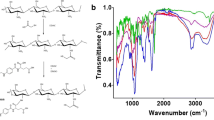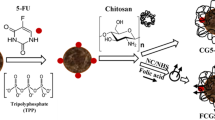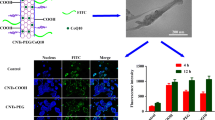Abstract
Carbon monoxide (CO) is an endogenously produced molecule and has shown efficacy in animal models of inflammation, organ injury, colitis and cancer metastasis. Because of its gaseous nature, there is a need for developing efficient CO delivery approaches, especially those capable of targeted delivery. In this study, we aim to take advantage of a previously reported approach of enrichment-triggered prodrug activation to achieve targeted delivery by targeting the folate receptor. The general idea is to exploit folate receptor-mediated enrichment as a way to accelerate a bimolecular Diels-Alder reaction for prodrug activation. In doing so, we first need to find ways to tune the reaction kinetics in order to ensure minimal reaction without enrichment and optimal activation upon enrichment. In this feasibility study, we synthesized two diene-dienophile pairs and studied their reaction kinetics and ability to target the folate receptor. We found that folate conjugation significantly affects the reaction kinetics of the original diene-dienophile pairs. Such information will be very useful in future designs of similar targeted approaches of CO delivery.






Similar content being viewed by others
References
Shoshan MC, Linder S. Target specificity and off-target effects as determinants of cancer drug efficacy. Expert Opin Drug Metab Toxicol. 2008;4:273–80. https://doi.org/10.1517/17425255.4.3.273
Sahoo S, Kariya T, Ishikawa K. Targeted delivery of therapeutic agents to the heart. Nat Rev Cardiol. 2021;18:389–99. https://doi.org/10.1038/s41569-020-00499-9
Khongorzul P, Ling CJ, Khan FU, Ihsan AU, Zhang J. Antibody-drug conjugates: a comprehensive review. Mol Cancer Res. 2020;18:3–19. https://doi.org/10.1158/1541-7786.Mcr-19-0582
Perez HL, Cardarelli PM, Deshpande S, Gangwar S, Schroeder GM, Vite GD, et al. Antibody-drug conjugates: Current status and future directions. Drug Discov Today. 2014;19:869–81. https://doi.org/10.1016/j.drudis.2013.11.004
Bae YH, Park K. Targeted drug delivery to tumors: myths, reality and possibility. J Control Rel. 2011;153:198–205. https://doi.org/10.1016/j.jconrel.2011.06.001
Liu P, Gao C, Chen H, Vong CT, Wu X, Tang X, et al. Receptor-mediated targeted drug delivery systems for treatment of inflammatory bowel disease: Opportunities and emerging strategies. Acta Pharm Sin B. 2021;11:2798–818. https://doi.org/10.1016/j.apsb.2020.11.003
Sudimack J, Lee RJ. Targeted drug delivery via the folate receptor. Adv Drug Deliv Rev. 2000;41:147–62. https://doi.org/10.1016/s0169-409x(99)00062-9
Young O, Ngo N, Lin L, Stanbery L, Creeden JF, Hamouda D, et al. Folate receptor as a biomarker and therapeutic target in solid tumors. Curr Probl Cancer. 2023;47:100917 https://doi.org/10.1016/j.currproblcancer.2022.100917
Scaranti M, Cojocaru E, Banerjee S, Banerji U. Exploiting the folate receptor α in oncology. Nat Rev Clin Oncol. 2020;17:349–59. https://doi.org/10.1038/s41571-020-0339-5
Xia W, Low PS. Folate-targeted therapies for cancer. J Med Chem. 2010;53:6811–24. https://doi.org/10.1021/jm100509v
Vlahov IR, Leamon CP. Engineering folate-drug conjugates to target cancer: from chemistry to clinic. Bioconjug Chem. 2012;23:1357–69. https://doi.org/10.1021/bc2005522
Low PS, Henne WA, Doorneweerd DD. Discovery and development of folic-acid-based receptor targeting for imaging and therapy of cancer and inflammatory diseases. Acc Chem Res. 2008;41:120–9. https://doi.org/10.1021/ar7000815
Poh S, Putt KS, Low PS. Folate-targeted dendrimers selectively accumulate at sites of inflammation in mouse models of ulcerative Colitis and Atherosclerosis. Biomacromolecules. 2017;18:3082–8. https://doi.org/10.1021/acs.biomac.7b00728
De La Cruz LK, Yang X, Menshikh A, Brewer M, Lu W, Wang M, et al. Adapting decarbonylation chemistry for the development of prodrugs capable of in vivo delivery of carbon monoxide utilizing sweeteners as carrier molecules. Chem Sci. 2021;12:10649–54. https://doi.org/10.1039/d1sc02711e
Ji X, Zhou C, Ji K, Aghoghovbia RE, Pan Z, Chittavong V, et al. Click and release: a chemical strategy toward developing gasotransmitter prodrugs by using an intramolecular Diels-Alder reaction. Angew Chem Int Ed Engl. 2016;55:15846–51. https://doi.org/10.1002/anie.201608732
Wang B, Otterbein LE. Carbon monoxide in drug discovery: basics, pharmacology, and therapeutic potential. John Wiley & Sons; 2022.
Otterbein LE, Bach FH, Alam J, Soares M, Tao Lu H, Wysk M, et al. Carbon monoxide has anti-inflammatory effects involving the mitogen-activated protein kinase pathway. Nat Med. 2000;6:422–8. https://doi.org/10.1038/74680
Ji X, Pan Z, Li C, Kang T, De La Cruz LKC, Yang L, et al. Esterase-sensitive and pH-controlled carbon monoxide prodrugs for treating systemic inflammation. J Med Chem. 2019;62:3163–8. https://doi.org/10.1021/acs.jmedchem.9b00073
Otterbein LE, Mantell LL, Choi AM. Carbon monoxide provides protection against hyperoxic lung injury. Am J Physiol. 1999;276:L688–94. https://doi.org/10.1152/ajplung.1999.276.4.L688
Kyokane T, Norimizu S, Taniai H, Yamaguchi T, Takeoka S, Tsuchida E, et al. Carbon monoxide from heme catabolism protects against hepatobiliary dysfunction in endotoxin-treated rat liver. Gastroenterology. 2001;120:1227–40. https://doi.org/10.1053/gast.2001.23249
Zuckerbraun BS, Billiar TR, Otterbein SL, Kim PK, Liu F, Choi AM, et al. Carbon monoxide protects against liver failure through nitric oxide-induced heme oxygenase 1. J Exp Med. 2003;198:1707–16. https://doi.org/10.1084/jem.20031003
Correa-Costa M, Gallo D, Csizmadia E, Gomperts E, Lieberum JL, Hauser CJ, et al. Carbon monoxide protects the kidney through the central circadian clock and CD39. Proc Natl Acad Sci USA. 2018;115:E2302–e10. https://doi.org/10.1073/pnas.1716747115
Nagasaki T, Maeda H, Yanagisawa H, Nishida K, Kobayashi K, Wada N, et al. Carbon monoxide-loaded red blood cell prevents the onset of cisplatin-induced acute kidney injury. Antioxidants. 2023;12. https://doi.org/10.3390/antiox12091705.
Zhang T, Zhang G, Chen X, Chen Z, Tan AY, Lin A, et al. Low-dose carbon monoxide suppresses metastatic progression of disseminated cancer cells. Cancer Lett. 2022;546:215831 https://doi.org/10.1016/j.canlet.2022.215831
Romao CC, Blattler WA, Seixas JD, Bernardes GJ. Developing drug molecules for therapy with carbon monoxide. Chem Soc Rev. 2012;41:3571–83. https://doi.org/10.1039/c2cs15317c
Motterlini R, Otterbein LE. The therapeutic potential of carbon monoxide. Nat Rev Drug Discov. 2010;9:728–43. https://doi.org/10.1038/nrd3228
Ling K, Men F, Wang WC, Zhou YQ, Zhang HW, Ye DW. Carbon monoxide and its controlled release: therapeutic application, detection, and development of Carbon Monoxide Releasing Molecules (CORMs). J Med Chem. 2018;61:2611–35. https://doi.org/10.1021/acs.jmedchem.6b01153
Bauer N, Yuan Z, Yang X, Wang B. Plight of CORMs: The unreliability of four commercially available CO-releasing molecules, CORM-2, CORM-3, CORM-A1, and CORM-401, in studying CO biology. Biochem Pharmacol. 2023;214:115642 https://doi.org/10.1016/j.bcp.2023.115642
Alghazwat O, Talebzadeh S, Oyer J, Copik A, Liao Y. Ultrasound responsive carbon monoxide releasing micelle. Ultrason Sonochem. 2021;72:105427 https://doi.org/10.1016/j.ultsonch.2020.105427
Stamellou E, Storz D, Botov S, Ntasis E, Wedel J, Sollazzo S, et al. Different design of enzyme-triggered CO-releasing molecules (ET-CORMs) reveals quantitative differences in biological activities in terms of toxicity and inflammation. Redox Biol. 2014;2:739–48. https://doi.org/10.1016/j.redox.2014.06.002
Heinemann SH, Hoshi T, Westerhausen M, Schiller A. Carbon monoxide–physiology, detection and controlled release. Chem Commun. 2014;50:3644–60. https://doi.org/10.1039/c3cc49196j
Aucott BJ, Ward JS, Andrew SG, Milani J, Whitwood AC, Lynam JM, et al. Redox-tagged Carbon Monoxide-Releasing Molecules (CORMs): Ferrocene-Containing [Mn(C;N)(CO)(4)] Complexes as a Promising New CORM Class. Inorg Chem. 2017;56:5431–40. https://doi.org/10.1021/acs.inorgchem.7b00509
Steiger C, Luhmann T, Meinel L. Oral drug delivery of therapeutic gases - carbon monoxide release for gastrointestinal diseases. J Control Rel. 2014;189:46–53. https://doi.org/10.1016/j.jconrel.2014.06.025
Anderson SN, Richards JM, Esquer HJ, Benninghoff AD, Arif AM, Berreau LM. A structurally-tunable 3-Hydroxyflavone motif for visible light-induced Carbon Monoxide-Releasing Molecules (CORMs). ChemistryOpen. 2015;4:590–4. https://doi.org/10.1002/open.201500167
Poloukhtine A, Popik VV. Highly efficient photochemical generation of a triple bond: synthesis, properties, and photodecarbonylation of cyclopropenones. J Org Chem. 2003;68:7833–40. https://doi.org/10.1021/jo034869m
Abeyrathna N, Washington K, Bashur C, Liao Y. Nonmetallic carbon monoxide releasing molecules (CORMs). Org Biomol Chem. 2017;15:8692–9. https://doi.org/10.1039/c7ob01674c
Palao E, Slanina T, Muchova L, Solomek T, Vitek L, Klan P. Transition-metal-free CO-releasing BODIPY derivatives activatable by visible to NIR light as promising bioactive molecules. J Am Chem Soc. 2016;138:126–33. https://doi.org/10.1021/jacs.5b10800
Min Q, Ni Z, You M, Liu M, Zhou Z, Ke H, et al. Chemiexcitation-triggered prodrug activation for targeted carbon monoxide delivery. Angew Chem Int Ed Engl. 2022;61:e202200974 https://doi.org/10.1002/anie.202200974
Sun Y, Neary WJ, Burke ZP, Qian H, Zhu L, Moore JS. Mechanically triggered carbon monoxide release with turn-on aggregation-induced emission. J Am Chem Soc. 2022;144:1125–9. https://doi.org/10.1021/jacs.1c12108
Xing L, Wang B, Li J, Guo X, Lu X, Chen X, et al. A fluorogenic ONOO(-)-triggered carbon monoxide donor for mitigating brain ischemic damage. J Am Chem Soc. 2022;144:2114–9. https://doi.org/10.1021/jacs.2c00094
Byrne JD, Gallo D, Boyce H, Becker SL, Kezar KM, Cotoia AT, et al. Delivery of therapeutic carbon monoxide by gas-entrapping materials. Sci Transl Med. 2022;14:eabl4135 https://doi.org/10.1126/scitranslmed.abl4135
Peng P, Wang C, Shi Z, Johns VK, Ma L, Oyer J, et al. Visible-light activatable organic CO-releasing molecules (PhotoCORMs) that simultaneously generate fluorophores. Org Biomol Chem. 2013;11:6671–4. https://doi.org/10.1039/c3ob41385c
Belcher JD, Gomperts E, Nguyen J, Chen C, Abdulla F, Kiser ZM, et al. Oral carbon monoxide therapy in murine sickle cell disease: Beneficial effects on vaso-occlusion, inflammation and anemia. PLoS One. 2018;13:e0205194 https://doi.org/10.1371/journal.pone.0205194
Pan Z, Chittavong V, Li W, Zhang J, Ji K, Zhu M, et al. Organic CO Prodrugs: Structure-CO-release rate relationship studies. Chemistry. 2017;23:9838–45. https://doi.org/10.1002/chem.201700936
Zheng Y, Ji X, Yu B, Ji K, Gallo D, Csizmadia E, et al. Enrichment-triggered prodrug activation demonstrated through mitochondria-targeted delivery of doxorubicin and carbon monoxide. Nat Chem. 2018;10:787–94. https://doi.org/10.1038/s41557-018-0055-2
Wang D, Viennois E, Ji K, Damera K, Draganov A, Zheng Y, et al. A click-and-release approach to CO prodrugs. Chem Commun. 2014;50:15890–3. https://doi.org/10.1039/c4cc07748b
Ji X, De La Cruz LKC, Pan Z, Chittavong V, Wang B. pH-Sensitive metal-free carbon monoxide prodrugs with tunable and predictable release rates. Chem Commun. 2017;53:9628–31. https://doi.org/10.1039/c7cc04866a
Pan Z, Zhang J, Ji K, Chittavong V, Ji X, Wang B. Organic CO prodrugs activated by endogenous ROS. Org Lett. 2018;20:8–11. https://doi.org/10.1021/acs.orglett.7b02775
Li Z, Wang Y, Liu M, Pan Y, Ni Z, Min Q, et al. Reactive oxygen species-activated metal-free carbon monoxide prodrugs for targeted cancer treatment. J Med Chem. 2023;66:14583–96. https://doi.org/10.1021/acs.jmedchem.3c01056
Kueh JTB, Stanley NJ, Hewitt RJ, Woods LM, Larsen L, Harrison JC, et al. Norborn-2-en-7-ones as physiologically-triggered carbon monoxide-releasing prodrugs. Chem Sci. 2017;8:5454–9. https://doi.org/10.1039/c7sc01647f
Bell NT, Payne CM, Sammut IA, Larsen DS. Mechanistic studies of carbon monoxide release from Norborn‐2‐en‐7‐one CORMs. Asian J Org Chem. 2022;11:e202200350.
Thiang Brian Kueh J, Seifert‐Simpson JM, Thwaite SH, Rodgers GD, Harrison JC, Sammut IA, et al. Studies towards non‐toxic, water soluble, vasoactive norbornene organic carbon monoxide releasing molecules. Asian J Org Chem. 2020;9:2127–35.
Ji X, Ji K, Chittavong V, Yu B, Pan Z, Wang B. An esterase-activated click and release approach to metal-free CO-prodrugs. Chem Commun. 2017;53:8296–9. https://doi.org/10.1039/c7cc03832a
Trindade AF, Frade RF, Maçôas EM, Graça C, Rodrigues CA, Martinho JM, et al. Click and go”: simple and fast folic acid conjugation. Org Biomol Chem. 2014;12:3181–90. https://doi.org/10.1039/c4ob00150h
Santos FMF, Matos AI, Ventura AE, Gonçalves J, Veiros LF, Florindo HF, et al. Modular assembly of reversible multivalent cancer-cell-targeting drug conjugates. Angew Chem Int Ed Engl. 2017;56:9346–50. https://doi.org/10.1002/anie.201703492
Kondengadan SM, Bansal S, Yang C, Liu D, Fultz Z, Wang B. Click chemistry and drug delivery: A bird’s-eye view. Acta Pharm Sin B. 2023;13:1990–2016. https://doi.org/10.1016/j.apsb.2022.10.015
De La Cruz LK, Ji X, Yang X, Wang B. Click, release, and fluoresce: In-vivo generation of CO with concomitant synthesis of a fluorescent reporter. Bioorg Med Chem. 2021;44:116297 https://doi.org/10.1016/j.bmc.2021.116297
Ji X, Wang B. Strategies toward organic carbon monoxide prodrugs. Acc Chem Res. 2018;51:1377–85. https://doi.org/10.1021/acs.accounts.8b00019
Breslow R. Hydrophobic effects on simple organic reactions in water. Acc Chem Res. 1991;24:159–64.
Li S, Yu B, Wang J, Zheng Y, Zhang H, Walker MJ, et al. Biomarker-based metabolic labeling for redirected and enhanced immune response. ACS Chem Biol. 2018;13:1686–94. https://doi.org/10.1021/acschembio.8b00350
Acknowledgements
The authors thank the financial support from the National Institutes of Health for our CO-related work (R01DK119202 for CO and colitis; R01DK128823 for CO and acute kidney injury). We also acknowledge financial support from the Georgia Research Alliance in the form of an Eminent Scholar endowment (BW), the Dr. Frank Hannah Chair endowment (BW), and other GSU internal resources. Mass spectrometric analyses were conducted by the Georgia State University Mass Spectrometry Facilities, which are partially supported by an NIH grant for the purchase of a Waters Xevo G2-XS Mass Spectrometer (1S10OD026764-01). Figure 2 is generated with Biorender.com.
Author information
Authors and Affiliations
Corresponding author
Ethics declarations
Conflict of interest
The authors declare no competing interests.
Additional information
Publisher’s note Springer Nature remains neutral with regard to jurisdictional claims in published maps and institutional affiliations.
Supplementary information
Rights and permissions
Springer Nature or its licensor (e.g. a society or other partner) holds exclusive rights to this article under a publishing agreement with the author(s) or other rightsholder(s); author self-archiving of the accepted manuscript version of this article is solely governed by the terms of such publishing agreement and applicable law.
About this article
Cite this article
Kondengadan, S.M., Bansal, S., Yang, X. et al. Folate-conjugated organic CO prodrugs: Synthesis and CO release kinetic studies. Med Chem Res (2024). https://doi.org/10.1007/s00044-024-03232-0
Received:
Accepted:
Published:
DOI: https://doi.org/10.1007/s00044-024-03232-0




